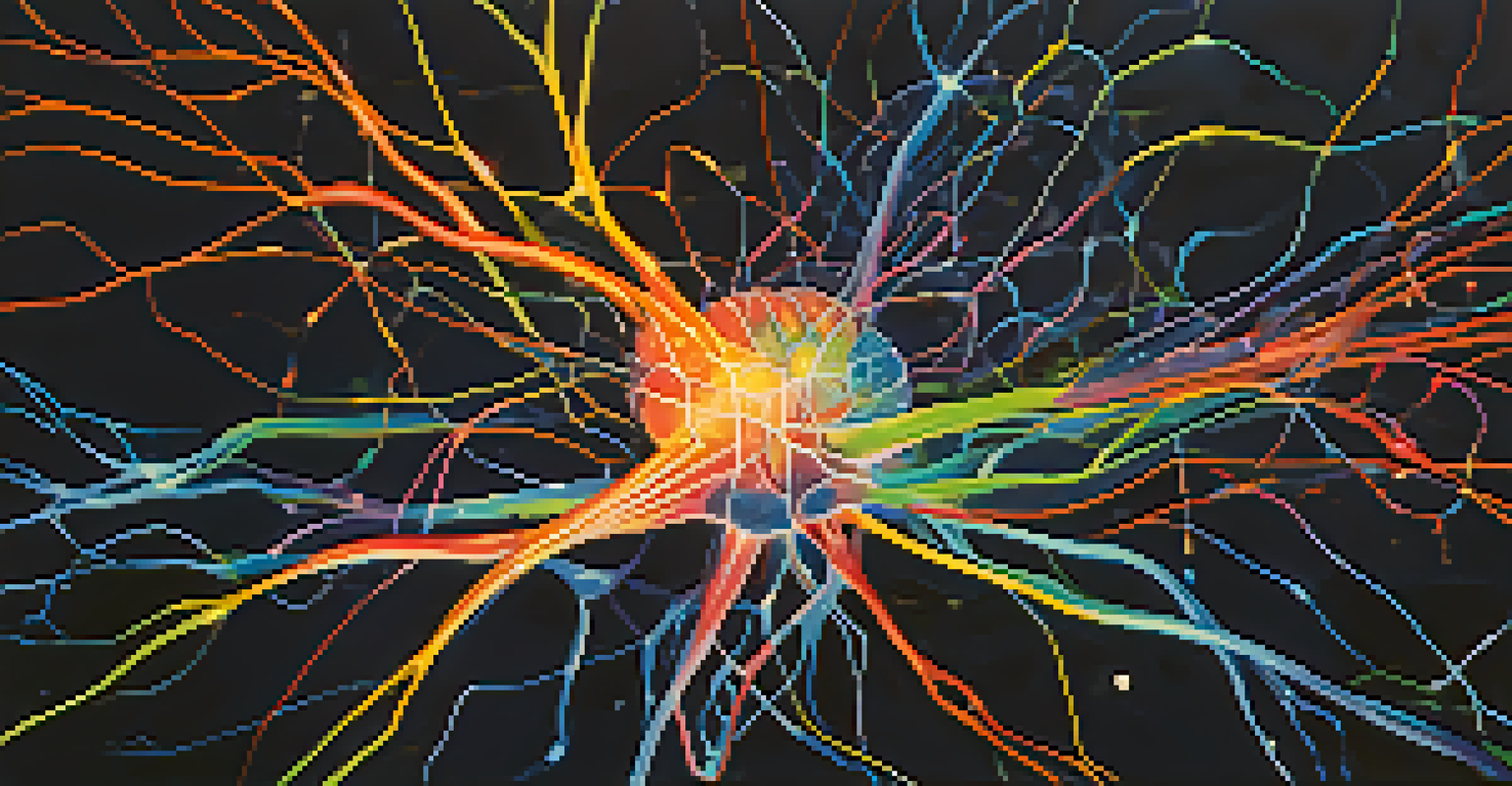Hallucinogens and the Brain: Impact on Dreaming Processes

Understanding Hallucinogens and Their Mechanisms in the Brain
Hallucinogens are substances that alter perception, mood, and cognitive processes. Common examples include LSD, psilocybin, and DMT. These substances interact primarily with serotonin receptors in the brain, which play a crucial role in regulating mood, perception, and even sleep.
Psychedelics can help us understand the nature of consciousness and the potential for healing through altered states of mind.
When consumed, hallucinogens can lead to profound alterations in consciousness, often resulting in vivid visual and auditory hallucinations. This shift in perception can significantly influence how we experience dreams, as the brain's pathways for processing sensory information become altered.
Understanding the basic mechanics of hallucinogens helps us explore their impact on dreaming. By altering neurotransmitter activity, these substances may affect not only what we perceive while awake but also how we dream when we sleep.
How Dreaming Works: The Science Behind It
Dreaming occurs during the REM (Rapid Eye Movement) stage of sleep, a phase characterized by increased brain activity. During this time, our brains process emotions, experiences, and memories, often weaving them into complex narratives that we experience as dreams.

The brain's dream production involves various regions, including the amygdala, which processes emotions, and the hippocampus, which plays a role in memory. This interplay creates a rich tapestry of dreams that can range from bizarre and surreal to deeply meaningful.
Hallucinogens Alter Dream States
Hallucinogens can enhance and modify dream experiences, creating vivid and emotionally charged dreams.
Understanding this process sets the stage for exploring how hallucinogens can influence dreams. When the normal function of these brain areas is altered, the content and nature of our dreams may change, leading to unique dreaming experiences.
The Connection Between Hallucinogens and Dream States
Research suggests that hallucinogens can enhance or modify dream states, often leading to more vivid and memorable dreams. Users have reported that their dreams can feel more real and emotionally charged after consuming these substances, highlighting a deeper connection between waking and dreaming states.
Dreams are the touchstones of our character.
This phenomenon may be due to the way hallucinogens alter neural pathways, creating a heightened state of awareness and emotional intensity. As a result, the boundary between reality and dreams can blur, allowing for extraordinary dream experiences.
The implications of this connection are fascinating. By understanding how hallucinogens impact our dream states, we can gain insights into the nature of consciousness and the potential therapeutic benefits of these substances.
The Role of Serotonin in Dreaming and Hallucinogens
Serotonin is a key neurotransmitter involved in mood regulation and is also critical in the dreaming process. Hallucinogens primarily act as serotonin receptor agonists, meaning they mimic the action of serotonin in the brain, leading to altered states of consciousness.
When serotonin receptors are stimulated by hallucinogens, they can enhance emotional experiences and perception. This change can extend into the dreaming process, making dreams feel more vivid, bizarre, or emotionally charged.
Serotonin's Role in Dreams
Serotonin, a key neurotransmitter, is influenced by hallucinogens, leading to altered dream content and emotional intensity.
Exploring the role of serotonin in both hallucinogen effects and dreaming provides a clearer picture of how these substances might alter our nighttime experiences. It raises questions about potential therapeutic uses for conditions like PTSD, where dream content can be distressing.
Potential Therapeutic Benefits of Hallucinogens in Dreaming
Emerging research suggests that hallucinogens may have therapeutic benefits, particularly in treating psychological conditions like depression and anxiety. By altering dream experiences, these substances could help individuals process trauma or unresolved emotions.
For example, some studies have indicated that psychedelics can lead to a reduction in nightmares and other distressing dream experiences. This therapeutic potential opens new avenues for treating conditions where dreaming plays a significant role in mental health.
Understanding the therapeutic benefits of hallucinogens in the context of dreaming emphasizes the importance of further research. It could lead to innovative treatments that harness the power of dreams for emotional healing.
Cultural Perspectives on Hallucinogens and Dreaming
Throughout history, various cultures have used hallucinogens for spiritual and healing purposes. Indigenous practices often incorporate these substances into rituals, fostering unique dream experiences that are believed to connect individuals with the spiritual realm.
These cultural perspectives offer valuable insights into the multifaceted relationship between hallucinogens and dreaming. They highlight how these substances can serve as gateways to deeper understanding and exploration of the self.
Therapeutic Potential of Hallucinogens
Emerging research suggests hallucinogens may help treat psychological conditions by improving dream experiences and processing trauma.
By recognizing and respecting these cultural contexts, we can appreciate the potential of hallucinogens to influence dream states and how they can be integrated into broader therapeutic practices.
The Future of Research on Hallucinogens and Dreaming
As interest in hallucinogens grows, so does the need for rigorous scientific research into their effects on dreaming. Understanding this relationship could unlock new treatments for mental health issues and expand our knowledge of consciousness.
Future studies may focus on how different types of hallucinogens influence dream content and quality. This research could provide insights into the mechanics of dreaming, potentially leading to new therapeutic approaches.

In conclusion, the exploration of hallucinogens and their impact on dreaming processes is still in its infancy. However, the promising findings thus far suggest a fascinating area of study with significant implications for mental health and our understanding of the human experience.